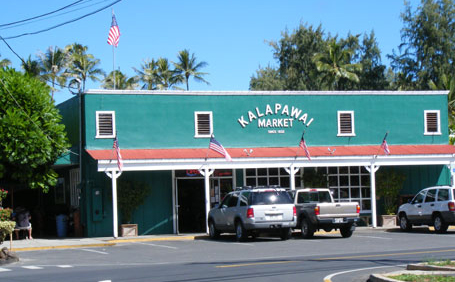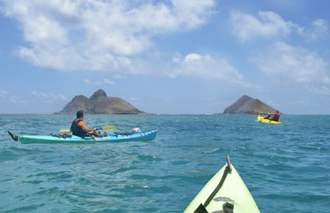The Kalapawai Market is a local institution, being the nearest eatery to Kailua and Lanikai beaches. It’s also the oldest market in that sleepy little beach town. We parked our kayaks next to the market’s shaded patio area along the Kailua Road side. In addition to a small grocery and sundries section, the market has a deli that serves up a unique assortment of local-flavored sandwiches, wraps, salads, coffees and ice cream.
We bought sandwiches and iced tea and went out to the patio. There wasn’t enough time for a leisurely lunch but it was a pleasant one nonetheless, infused with plenty of local ambience. Kailua is an old-fashioned beach town that has managed not to become too touristy because surprisingly few tourists venture out that way. Most of the people in the beach area are locals.
 The Kalapawai Market is Kailua’s oldest market and about a block from Kailua Sailboards, making it a good place to have lunch before heading on to Kailua Beach.
The Kalapawai Market is Kailua’s oldest market and about a block from Kailua Sailboards, making it a good place to have lunch before heading on to Kailua Beach.After lunch we pulled the kayaks the remaining quarter mile or so to the point at the Kailua Beach parking lot where a wooden ramp had been set up to make it easier to pull the kayaks up the curb onto the gentle sandy rise overlooking the beach. We spotted the rows of trucks left by other Kailua Sailboard kayak renters and pulled our kayaks off their trucks. Pulling the wheel-less kayaks down the sand about two hundreds yards to the edge of the surf took some effort, especially the tandem.
We opened up the big red dry bag and fed it everything that wasn’t waterproof or that we didn’t want falling into the sea in case we capsized. After all, the wind was scalloping the bright aqua sea. We zipped the bag closed and secured it to the tandem kayak using a criss-cross of webbing clipped to metal rings on the kayak.
We pulled our teen’s single kayak out to waist-deep water. There was some wave action but it was straight on. As long as we kept the kayak perpendicular to the waves, we didn’t have much trouble keeping it under control. Our teen tipped herself into her seat nicely and began paddling as I gave it a shove out toward deeper waters. Within seconds she was safely out past the breaking surf and happily paddling away from the beach.
Launching our tandem kayak was another matter. Despite her life vest, the spouse’s earlier misgivings about the wisdom of kayaking on the ocean quickly turned into a kind of fear-induced paralysis. As we moved the kayak out into waist-deep water, she suddenly decided that she wasn’t willing to risk her life to paddle out to some little island. I struggled to keep the kayak upright and perpendicular to the waves as she went through her crisis of faith, then made a half-hearted attempt to lift herself onto the kayak’s front seat. In the process, the kayak took on a large amount of water. I told her to let go, then pulled the kayak back to the beach so I could tip the water out while she had a chance to regain her composure.
On our second try, the spouse had managed to suppress her trepidation with a do-or-die attitude. When we had pulled the kayak out to waist deep water, she scrambled onto the kayak while I help it steady. She managed to seat herself and grab her paddle, leaving me free to get aboard and start paddling through the breaking surf. Within a few seconds we were on our way though it probably took considerably longer for the spouse to stop trembling and dig in with effective paddling.
Rather than aiming directly for the Mokes far off toward our right, we paddled straight away from shore. The safety video had warned that the lifeguards could slap a big fine on kayakers dallying near the beach among the swimmers. We were about two hundred yards out from the beach before we cut to the right and headed southward, trying to keep at least a diagonal attitude toward the waves that kept lifting and dropping us. To avoid the chance of being tipped over we paddled diligently after our teen who was about a hundred yards ahead of us.
It took some real effort for us to cover much water because we were going directly against a strong persistent current. The skin on the cusp between our thumbs and index fingers began to feel raw. We switched our grips to bring our thumbs around parallel to our fingers to avoid getting blisters.
We never felt completely safe from the danger of being tipped over by the constant swells that kept coming to meet us at an angle from our port side. That didn’t keep us from coming alive to the glory of slicing through a postcard scene of blue over aqua toward tiny tropical islands that looked dauntingly far away. It was becoming apparent that we wouldn’t be reaching them without more hard paddling than we had bargained for. Our exertion, combined with the blazing sun on our faces and the persistent breeze, reminded us that we weren’t in a postcard but in a real-life adventure.
As we paddled slowly past Flat Island to our left we saw groups of kayakers who had chosen the less ambitious goal of landing there. The effort we were making to fight the current and keep the kayak at an angle to the bigger swells made me wonder briefly whether we shouldn’t follow their example. But seeing our teen paddling bravely ahead of us kept us determined to persevere until we had conquered time and distance — and returned in time for a nice big dinner at the Regency Club. We weren’t even halfway to the Mokes and I could feel myself getting hungry despite our recent lunch. Had we not stopped for lunch we would have been faint from hunger.
Soon after passing Flat Island we encountered a stretch of big flat submerged rocks that were barely a foot or two below the bottom of our kayak. Each passing swell lifted us up from the port side and dropped us on the starboard just a few inches above the rocks. We tried to maneuver away from the reef by angling farther from the beach, but the rocks were everywhere. A couple hundreds yards ahead and to the left of us were some kayaks that had disregarding the safety video’s elongaged reverse-S course. We wondered if that route may not have spared us the need to traverse the reef.


